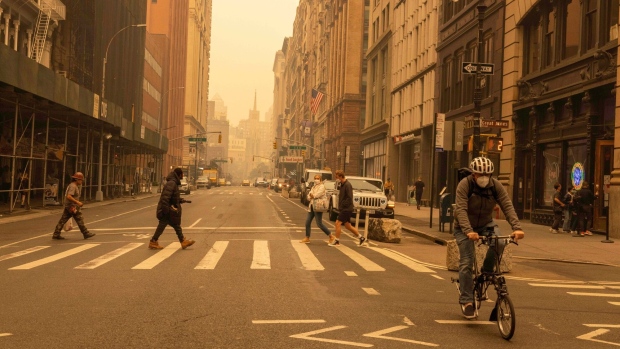Jun 8, 2023
New York’s Toxic Wildfire Smoke Is All Too Familiar to Asia
, Bloomberg News

(Bloomberg) -- As New Yorkers breathe in the most polluted air in decades, experience from places more regularly struck by wildfires suggests that avoiding the smoke is almost impossible and the health impacts are long-lasting and grim.
From Singapore and Indonesia to Australia, three of the countries in Asia most frequently impacted by smoke from burning trees or smoldering forests, attempts by residents to deal with the toxic fallout have become an annual ritual of sorts.
Typically, the solutions — like those offered by New York City Mayor Eric Adams — are short-term: Stay inside and close the windows. But that becomes impractical in the case of longer-burning blazes, and fire seasons are getting longer almost everywhere around the world.
Climate change is making seasonal wildfires more unpredictable, threatening widespread devastation as the impacts of drought and blazes stretch across borders. The smoke and the acrid burning smell in New York’s air may be a sign of what’s to come this year as an anticipated El Niño increases the risk of fires in parts of Asia.
“Nowhere is immune,” said Arnagretta Hunter, a Canberra-based physician and cardiologist and Human Futures Fellow at the Australian National University. “I worry that we think there are privileged parts of the world that will not be vulnerable to climate events, and that’s not the case.”
Hazardous levels of smoke can bring daily life to a halt. Coping strategies include shutting schools, curbing outdoor work, grounding planes and preparing medical facilities in anticipation of a surge in respiratory diseases. Farmers need to protect crops — grapes in Australia have had to be discarded after fires due to flavor changes.
Australia’s Black Summer offers a painful lesson in the potential catastrophic dangers. Three and a half years ago, smoke from one of the worst wildfire seasons on record blanketed 80% of the population. A suffocating red-tinged haze covered Sydney, while tennis players at the Australian Open in Melbourne were left gasping for air on court.
After nine months when the blazes burnt out, scientists estimated 429 people had died from exposure to dirty airborne particles, dwarfing the death toll of 33 from the fires themselves. An area roughly equivalent to half of California had been destroyed.
Read More: Wildfire’s Toxic Legacy Has Children Gasping for Air Years Later
Australia’s position as the driest inhabited continent puts it at a constant disadvantage in the face of climate change. It’s bracing for heat waves and intense bushfires this year as El Niño may bring hotter and drier conditions. The country just had its second-driest May on record.
While the health impact of Australia’s fires was huge, given the far larger population exposed to smoke from Canada’s massive wildfire season, the burden might be even higher, said Hamish Clarke, a senior research fellow at the University of Melbourne who specializes in wildfire management and risks.
Hunter at the Australian National University points out that the current situation in America and Canada is a consequence of just over 1C of global warming disrupting weather cycles. It will get significantly worse if overall temperature change tops 1.5C or 2C, she said.
Eight of California’s 10 largest fires on record have occurred since 2017. Even the Arctic is likely to experience a significant increase in burning this century, according to the United Nations.
In Asia, Bangkok and other Thai cities recently suffered from air pollution so bad that millions of people were diagnosed with respiratory illnesses. Singapore has warned of likely transboundary haze through October, advising the public to prepare face masks and air purifiers.
Indonesia contends with forest fires annually. The burning usually peaks from July to October during the dry season, with many of the fires set deliberately to clear land for plantations. The smoke that drifts from Sumatra and Kalimantan chokes neighboring Singapore and Malaysia regularly and has sparked diplomatic rows for decades.
Faced with such constant smoke exposure, Asia over the last 20 years has had a gradual increase in policies to curtail issues related to pollution, including putting legal responsibilities on companies, said Khor Yu Leng, a regional economist at Segi Enam Advisors.
After Australia’s Black Summer fires of 2019 and 2020, the government’s scientific research agency and the Bureau of Meteorology started work on a longer-term weapon to cope with toxic fumes — a prototype smoke-forecasting system to give residents warning of what conditions to expect.
One jurisdiction, the Australian Capital Territory, is setting up community refuges with air filters and making buildings more resilient to smoke. Authorities in all Australian states and territories have already agreed on a national framework for public air-quality information and health advice.
When air quality plummets, the first step is usually to shut schools, said Helena Varkkey, a professor of environmental politics at the University of Malaya in Kuala Lumpur. This makes children who are more vulnerable stay home, and parents too, as they’ll have to care for the kids. This will take cars off the road to reduce baseline pollution.
Smoke exposure can make people sick, especially those working outdoors. Businesses need to be prepared if employees are unable to work, and also provide face masks, air purifiers, air conditioners to make sure they are adequately protected, she said. Most countries in Southeast Asia have early warning systems, and some even control prices and supply of N95 masks.
Indonesia has “oxygen houses” where children can go for fresh air. Singapore has a haze subsidy program to reduce medical costs for haze-related conditions. “These are some measures that can be considered for other countries experiencing similar problems around the world,” Varkkey said.
--With assistance from Sanjit Das and Anuradha Raghu.
©2023 Bloomberg L.P.






